Written by total scifi online
 The movies on this list are a good indicator of just how diverse the science fiction genre is. From the epic philosophical ideas of 2001: A Space Odyssey and Solaris to the joyful space opera of Star Wars and Flash Gordon, the films here are linked by their ability to explore time and space with imagination, flair and audacity.
The movies on this list are a good indicator of just how diverse the science fiction genre is. From the epic philosophical ideas of 2001: A Space Odyssey and Solaris to the joyful space opera of Star Wars and Flash Gordon, the films here are linked by their ability to explore time and space with imagination, flair and audacity.
This list is the result of heated debate/scuffles between the frazzled writers of Total Sci-Fi. In addition to settling on the titles themselves, we also had to set the limits of what counts as a ‘sci-fi film’: we decided that superhero movies were out as that’s a distinct genre all of its own, but comedies like Sleeper and Galaxy Quest possess enough genuine science fiction concepts to warrant inclusion. So here, then, is our list of the 100 Greatest Sci-Fi Movies. And as always you can drop us a line at [email protected] to let us know what you think should have made the cut and what shouldn’t…
1) Blade Runner (1982)

Like many of the movies on this list, Blade Runner was not a critical or commercial success on its initial release. Some critics at the time simply dismissed it as style over substance. Yet, along with its unforgettable depiction of a neon-lit LA that is essentially a mash-up of Western and Eastern cultures, Ridley Scott’s film is backed up by a real sense of sadness, fear and longing, and an often overlooked wry humour. As Deckard, Harrison Ford proved he could pull off a much darker hero than Han Solo, and Rutger Hauer gave the performance of his career as the psychotic, feral and ultimately tragic Roy Batty. A masterpiece.
2) 2001: A Space Odyssey (1968)

Stanley Kubrick’s grand, mind-bending trip into the unknown is science fiction of grand ideas. At times the film is as enigmatic as the universe itself, and Kubrick works in everything from human evolution to the perils of technology, and unlike many later spectacle-driven genre films, there is a real depth behind the groundbreaking special effects. Complex, strangely unsettling and magnificent.
3) Star Wars (1977)

Iconic, spectacular, groundbreaking, epic in both scope and ambition – if you haven’t seen Star Wars then, well, you’re probably not interested in reading a list about SF movies. While it might not convey the big science fiction ideas of other movies on this list, Star Wars works because it is pure, escapist fun and because it successfully builds a believable, cohesive galaxy that we are still exploring to this day.
4) Alien (1979)

On paper the plot sounds simple stuff: the crew of a spaceship are stalked by a relentless monster. Yet this is anything but a simple movie. It’s been much analysed by theorists for its portrayal of femininity (both in the strong heroine of Ripley and the film’s sexual imagery), while all of the crew members are complex and believable creations. And, of course, it’s incredibly frightening: the unveiling of Ash’s true identity is almost as scary as the xenomorph itself.
5) Metropolis (1927)

Over 80 years since it was originally released, Metropolis retains its power to awe. Fritz Lang creates a dazzling (and much-aped) vision of an industrial dystopia, but after its 1927 premiere the film only existed in a heavily edited version until it enjoyed a full reconstruction in 2002.
6) The Day the Earth Stood Still (1951)

The definitive 1950s SF flick holds an obvious warning about the increasing brinkmanship between the USA and USSR, but the story of alien fugitive Klaatu actually unfolds in a calm and surprisingly realistic manner. The special effects, including the flying saucer and robot companion Gort, are a lot more convincing than in the 2008 CG-heavy remake.
7) The Terminator (1984)

James Cameron works wonders on a minuscule budget in this tense and incredibly efficient thriller. The tantalising glimpses of the future war are more frightening than those seen in the recent big budget Terminator: Salvation, and Brad Fiedel provides one of the most memorable movie theme tunes of all time. And though he may not have troubled the Oscars, Schwarzenegger’s lack of emotional range is perfectly suited to the relentless killing machine.
8) Planet of the Apes (1968)

A dramatic crash landing and a shrieking shrivelled corpse signal the start of this intelligent allegory, made at the height of the cold war. Its ending is one of the most iconic moments in cinema, bringing to a close the first chapter of the first major science fiction franchise.
9) E.T. (1982)

E.T. is warm-hearted without descending into mawkishness. In part this is down to natural performances from Henry Thomas and Drew Barrymore as the children who treat their alien visitor with respect and kindness – in contrast to most of the adults in the picture. In fact E.T. becomes kind of frightening in the second half with the doctors flocking around the little fellow and suits waving guns around (or rather less threatening walkie-talkies if you’re watching Spielberg’s revised version).
10) Solaris (1972)

Andrei Tarkovsky’s existential SF drama is often described as the Russian 2001 – but it’s much more than that. It’s a hypnotic, minimalist masterpiece, though these days it has as many detractors as fans. Steven Soderbergh directed a surprisingly successful remake in 2002.
11) Close Encounters of the Third Kind (1977)
Cerebral narrative and whimsical fantasy are not always comfortable bedfellows, but Steven Spielberg’s 1977 classic handles both with ease. Whether it’s the restrained original or the unnecessary special edition, Close Encounters is a thoughtful tale that is as much inspiring as it is life affirming.
12) Forbidden Planet (1956)
It’s The Tempest in space! And it’s still brilliant! One of the most colourful, charming SF films ever made, FP’s highlights include the benign Robbie the Robot and the bloodcurdling invisible Id monster…
13) The Empire Strikes Back (1980)
Sequels don’t get any better than this. Opening with the Hoth battle and concluding with Darth Vader’s dramatic revelation to Luke, The Empire Strikes Back is constructed of scenes awash with imagination. The film also saw real emotional development for its leads and some great new characters like Lando and Boba Fett.
14) A Trip to the Moon (1902)
Georges Méliès’s 14-minute wonder astonished audiences at the turn of the 20th Century – and still does today. Méliès was one of the founding fathers of cinema, and this early narrative movie contains pioneering special effects and editing techniques. The Smashing Pumpkins’ video Tonight Tonight was inspired by the film.
15) Aliens (1986)

James Cameron cleverly eschewed aping the original, and instead upped the alien quotient and delivered one of the most purely exciting films ever made. But this is no brainless actioner. Cameron waits almost an hour before the acid-blooded xenomorphs make an appearance, while the film transformed Ripley into a bona fide iconic action heroine. There’s also a memorable selection of supporting characters (Hicks, Hudson, Newt, Vasquez) and instantly quotable dialogue (“game over man!”).
16) Silent Running (1972)
‘Eco-themed sci-fi’ isn’t the most exciting phrase in the world, but Douglas Trumball’s masterpiece isn’t An Inconvenient Truth in space. It’s a distillation of early 1970s ideals, with a moving, subtle performance from a youthful Bruce Dern. And with Trumball in the director’s chair, it’s no surprise that that the effects are terrific.
17) Brazil (1985)
Terry Gilliam’s best movie was a flop on its initial US release, but is now recognised as a SF masterpiece. A dystopian thriller with a large dose of Python-esque humour, Brazil remains a true one off.
18) Akira (1988)
Akira was instrumental in the explosion of interest in anime and manga in the English-speaking world, and influenced pretty much every SF anime movie that followed. It’s difficult to follow at times, but the film remains a dizzying achievement.
19) Star Trek II: The Wrath of Khan (1982)
The best Trek movie by miles, this is an edgy, exciting and often very funny movie that feels much more than an extended TV episode. The makers even had the guts to kill Spock! OK, so they did bring him back in the next one…
20) Total Recall (1990)
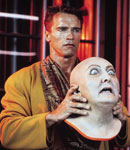
Based (very) loosely on Philip K Dick’s short story We Can Remember It For You Wholesale, Total Recall has both brains and brawn. When Arnie discovers that his memories are fake, he heads to Mars to find the truth. Cue foul-mouthed robot taxi drivers, ultra-violence and a three-breasted woman.
21) The Matrix (1999)
The Wachowski Brothers’ movie had it all: groundbreaking ‘flo-mo’ battles, ice cool characters, nods to spaghetti westerns and a large dose of cod philosophy, in an innovative, much-loved actioner. Even the lame sequels can’t detract from the film’s ingenuity.
22) Tron (1982)
Tron was ignored for many years, but is now widely accepted as a genre landmark, combining stunning – and unique – computer graphics in an effectively simple story of programmers battling inside an electronic world. The long-awaited sequel, Tron Legacy, is expected in 2010.
23) The Thing (1982)
A much-improved remake of 1950s quickie The Thing From Another World, John Carpenter’s best movie is an unbearably tense story of a shape-shifting alien at an Antarctic research station. A tight and astonishingly bleak chiller, The Thing boasts well-drawn characters and sick, sick effects from Rob Bottin.
24) RoboCop (1987)
Part man, part machine, all cop! Paul Verhoeven’s ultra-violent satire is lean, mean and often very funny, and benefits from great playing from the likes of Kurtwood Smith, Ronny Cox, Nancy Allen and, of course, Peter Weller as Murphy.
25) Jurassic Park (1993)

It was as if Spielberg had rediscovered what he loved about cinema in the first place after years of ‘serious’ Oscar-chasing movies. The magic mix of photo-realistic dinosaurs, a thrilling adventure story and a group of protagonists you could actually care about made for a movie that really seemed to be 65 million years in the making!
26) Invasion of the Body Snatchers (1978)
If the 1950s version of Jack Finney’s novel was a neat distillation of 1950s Commie paranoia (see No. 56), the 1970s remake was fuelled by post-Watergate paranoia. The result is entirely gripping and arguably better than the original.
27) A Clockwork Orange (1971)
Anthony Burgess’s novel may have seemed unfilmmable, but then Kubrick was always the kind of director who could pull off the impossible. Kubrick retains Burgess’s satirical bite in a chilling and darkly funny vision of the future, while a superb Malcolm McDowell makes the Droog leader, Alex, simultaneously repellent and likeable.
28) The Fifth Element (1997)
Luc Besson eschewed the traditionally dark predictions of the far future in favour of eyepoppingly colourful cityscapes and elaborate Gaultier-designed costumes. Forget the plot, and soak up the visuals and excess.
29) La Jetée (1962)
This 28-minute masterwork from documentary filmmaker Chris Marker tells of a man sent back through time to avert the apocalypse. A bold, disorientating and unforgettable experience, the film is told entirely through a series of still photos, and was remade by Terry Gilliam as Twelve Monkeys (see No. 83).
30) Sleeper (1973)

“We’re here to see the nose. I hear it was running…” The best of Woody Allen’s ‘early funny ones’, Sleeper takes a classic SF concept (Allen’s typically neurotic Miles Monroe wakes up 200 years in an authoritarian future) and delivers slapstick and gags with machine-gun accuracy. Who hasn’t wished that the Orgasmatron booth was real?
31) The Fly (1986)
David Cronenberg’s best film is a deliriously gory remake of the hokey 50s movie about a scientist (a superb Jeff Goldblum) whose genes get mangled with the DNA of a fly. Cue crumbling body parts and a bone-breaking arm wrestle.
32) Terminator 2: Judgement Day (1991)
Proving that science fiction can present thoughtful, bold concepts alongside explosions, robots comprised of liquid and a wisecracking kid, T2 is James Cameron at his excessive best. Arnold Schwarzenegger plays to his strengths as the muscle-bound machine, while Linda Hamilton toughens up as Axl Rose lookalike Sarah Connor.
33) Westworld (1973)
Before The Terminator and Jurassic Park there was Westworld! Michael Crichton’s film moves smoothly from playful fun to nailbiting thriller as Yul Brynner’s robotic gunslinger stalks theme park customers.
34) Mad Max 2 (aka The Road Warrior) (1981)
If the original was raw, energetic and brutal, the sequel took things to a whole new level as Max helps a community defend itself from crazed punks. Highlight: the boomerang sequence.
35) Return of the Jedi (1983)
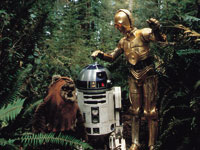
OK, so the Ewoks and abrupt death of Boba Fett continue to divide opinion, but ROTJ contains more memorable sequences than most movies could dream of: Luke’s battle against the Rancor monster; the Sarlacc’s pit; the speeder bike chase and a fitting conclusion.
36) Back to the Future (1985)
The much-loved sci-fi comedy sees Michael J Fox at his baffled-looking best, and he bounces perfectly off Christopher Lloyd’s wild-haired Doc Brown. Plus there’s the iconic De Lorean, charming supporting playing (Crispin Glover, Lea Thompson, Thomas F Wilson) and crowdpleasing scenes like Marty inventing rock n roll. Followed by two enjoyable sequels.
37) WALL-E (2008)
Arguably Pixar’s finest achievement to date, the first half of WALL-E contains a surprisingly haunting vision of the future – one of atomic storms, trash towers and rubble-strewn cities. Of course, it’s not all doom and gloom, and the film features loveable characters, a touching love story and a hilarious depiction of a porcine human race.
38) The Fantastic Planet (1973)
Cult French director René Laloux was responsible for a handful of surreal animated masterpieces, including Gandahar and The Time Masters, but his most celebrated work remains this weird and wonderful depiction of an alien world in which humans are kept as domestic pets.
39) The Man Who Fell to Earth (1976)
What’s it about? Who knows! David Bowie takes time out from being weird on stage to be odd on film in this surreal Nic Roeg movie. Look out for a cameo appearance by Apollo 13’s Jim Lovell looking just as bemused as the audience. We were hoping to avoid calling it a space oddity, but annoyingly that’s exactly what it is.
40) Things to Come (1936)

A big budget treatment of HG Wells’s future history of Everytown, from 1940 to 2036, Things to Come has barely dated. The effects, from the air raid sequences to the vision of a future society, are still awe-inspiring, but the political and prescient script keeps things grounded in reality.
41) 20 Million Miles to Earth (1957)
A reptilian monster from Venus, dubbed the ‘Ymir’, goes on the rampage in one of the best creature features. The film contains some of Ray Harryhausen’s best stop-motion work, and even its faults (stilted acting, nonsense science, comedy Italian accents) have become endearing over time.
42) The Abyss (1989)
James Cameron again pushed the boundaries of CGI with the still-impressive water-alien sequence, but away from the effects, the movie is an ambitious and brilliantly claustrophobic drama about the crew of an undersea oil rig. The Special Edition improved upon the fumbled ending.
43) Quatermass 2 (1957)
Based on the TV serial of the same name, the second Quatermass movie is a full-on conspiracy thriller, as aliens infiltrate the government. A classic invasion tale, it’s an exciting adventure, briskly paced even by today’s breakneck standards.
44) This Island Earth (1955)
Admittedly, ‘Exeter’ isn’t the most exotic name for an alien. But we’ll overlook that as This Island Earth is such damn good fun. This slice of pulp fiction contains some of the best effects of the period, along with groundbreaking use of Technicolor and an awesome crab-handed mutant.
45) Eternal Sunshine of the Spotless Mind (2004)

From the incomparable mind of Charlie Kaufman came this SF twist on the romantic comedy. A restrained Jim Carrey and a kooky Kate Winslet are the ex-lovers who have their minds wiped to forget about each other – but then fall in love all over again. Despite the outlandish conceit, this is a strangely honest movie about love and heartbreak.
46) Delicatessen (1991)
A post-apocalyptic cannibal comedy about a former circus clown… Describing Delicatessen doesn’t do it justice. Directing duo Marc Caro and Jean-Pierre Jeunet take a potentially bleak subject matter and construct a rapid-paced romantic comedy with old school slapstick, truly odd characters and visuals to die for.
47) Dark Star (1974)
Before Alien Dan O’Bannon scripted a very different story of a space crew in the low budget debut from director John Carpenter. The crew aboard Dark Star spend most of their time trying to stave off boredom, before having to deal with a sentient bomb.
48) The Andromeda Strain (1971)
Films don’t get more nailbiting than Robert Wise’s thriller about a group of scientists investigating a deadly alien organism. A faithful adaptation of Michael Crichton’s novel, which was also remade as a plodding miniseries in 2008.
49) The Omega Man (1971)
The best of the three official adaptations of Richard Matheson’s novel I Am Legend so far, this version sees Chuck Heston as the last man left in a city of mutants. It lacks Matheson’s dark humour and slow-burn storytelling, but remains an enduring thinking man’s actioner.
50) Stalker (1979)

Tarkovsky’s other sci-fi great is a 163-minute philosophical adaptation of the Strugatsky brothers’ Roadside Picnic. A ‘stalker’ guides two explorers to the Zone, which contains the key to realising innermost desires. Slow, inscrutable, beautiful and mesmerising.
51) Tetsuo: The Iron Man (1989)
OK, so there’s this fetishist, right, who likes to stick metal in himself. He then turns into a scrap-metal man and proceeds to stalk the woman who ran him over… Even describing Tetsuo is enough to make you sound like a babbling madman, and director Shinya Tsukamoto shoots the juddering blank-and-white cyberpunk action like no other filmmaker on Earth.
52) Escape from New York (1981)
Snake Plissken is one of cinema’s great action-hero, with Kurt Russell on top tough guy form. The plot, meanwhile, has influenced everything from District 13 to Doomsday, and it boasts John Carpenter’s best synth soundtracks.
53) The Invisible Man (1933)
HG Wells’ novel has been filmed many times (and influenced countless others), but the best adaptation remains James Whale’s atmospheric chiller. Pioneering special effects, a darkly witty script and, in his screen debut, a terrific performance from Claude Rains (carried mostly by just his distinctive voice) as the scientist-come-invisible-psycho.
54) It Came From Outer Space (1953)
A meteor crashes in the Arizona desert. But could it actually be an alien spacecraft? And could it be behind the weird behaviour of the townsfolk? Er, yes, it could. Another one of the greats from the 50s SF cycle, this atmospheric, hokey hit was originally shown in 3D.
55) Godzilla (1954)

The original stompin’ monster movie! Godzilla (or Gojira, depending on your phonetic preference) sees the titular atomic bomb-awakened creature lay waste to Tokyo. A destructive and sometimes frightening manifestation of atomic angst that sparked off the craze for man-in-a-suit-stomping-on-cardboard-sets action. An edited version of the movie was released in the States under the title Godzilla: King of the Monsters.
56) Invasion of the Body Snatchers (1956)
The first pod person chiller is a frightening bit of anti-commie science fiction (though producer Walter Mirisch and star Kevin McCarthy insisted that no allegorical element was ever intended). It’s a tense and tightly plotted film, that’s far less pulpy than the majority of the alien invasion pics of the period.
57) Minority Report (2002)
A ludicrously underrated science fiction epic that’s part detective story, Minority Report offers twists and turns galore, along with some truly leftfield moments. An awkward leap from hover car to a yoga class, a bizarre kiss from an older female scientist and a weird eye transplant sequence signal that this isn’t your run-of-the-mill genre picture.
58) Alphaville (1965)
New Wave sci-fi noir from Jean-Luc Godard. Set in the future city of the title (though obviously filmed in contemporary Paris), it’s a film that positively delights in narrative obfuscation and philosophical meanderings. Hip, clever and fun or dull and frustrating, depending on your point of view, but there’s no denying its originality or influence.
59) Gattaca (1997)
Criminally ignored by audiences at the time, Gattaca is a slow but involving ‘genetics noir’ that is driven by ideas rather than action. Ethan Hawke and Jude Law have never been better as the pair who strike an uneasy bargain, and there’s something disquieting about the shimmering retro-future visuals.
60) The Fountain (2006)
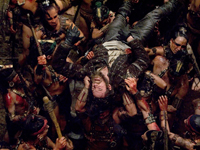
Another love it or hate it picture (and many hated it), The Fountain is about as idiosyncratic as genre filmmaking gets. Criss-crossing time and space, it’s a visual delight, but heartfelt performances from Hugh Jackman and Rachel Weisz ensure there’s a human element to the story.
61) Them! (1954)
The army fight radioactive giant killer ants! As premises go, it’s a pretty hard one to beat, and the Oscar-nominated bug effects hold up better than the majority of films from the period. Plus the tagline is awesome: “A horror horde of crawl-and-crush giants clawing out of the earth from mile-deep catacombs!”
62) Videodrome (1983)
David Cronenberg’s body horror about mutations and the media has some wonderfully crackers idea – not least the central conceit of a vagina-eseque VCR appearing in the lead character’s stomach. Disturbing, imaginative and complex. Oh yes, and twisted.
63) Logan’s Run (1976)
A simple but effective futuristic concept – people are killed when they reach the age of 30, but a couple rebel and run from their fate – leads to an exciting, if slightly kitsch slice of 70s SF. It has dated more than other titles on this list, but it’s still great fun.
64) Ghost in the Shell (1995)
Along with Akira (see No. 18), Mamoru Oshii’s is one of the most influential anime movies. Based on the manga by Masamune Shirow, Ghost in the Shell is a joyously convoluted cyberpunk extravaganza that seamlessly combines both cell and computer animation. Its success prompted a sequel and the Stand Alone Complex TV series.
65) Repo Man (1984)
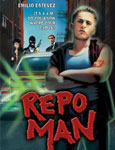
A scattershot blend of pokerfaced comedy, science fiction and youth pic, Alex Cox’s feature-length debut is a punk masterpiece. A young Emilio Estevez is brilliant as Otto, the reluctant repo man, and the strange, deadpan dialogue (“Suddenly someone’ll say plate, or shrimp, or plate o’ shrimp out of the blue…”) is hilarious.
66) Children of Men (2006)
The film version of PD James’s novel is powerful stuff, as it explores a future not so dissimilar from our present. Director Alfonso Cuarón paints a convincing picture of urban decay, and the handheld camerawork lends the action a sense of documentary-style realism.
67) Star Trek VI: The Undiscovered Country (1991)
The second-best Trek movie is also directed by Nicholas Meyer. This one’s a thrilling, funny conspiracy thriller that sees the aging Starfleet heroes attempt to avert intergalactic war. Hugely enjoyable.
68) Outland (1981)
Like the later Enemy Mine (which reworked Hell in the Pacific) Peter Hyams’ movie is a SF spin on a classic movie – this time, High Noon. Sean Connery’s Marshall heads to a mining outpost Jupiter’s moon Io to investigate the death of miners, and becomes caught up in a corporate conspiracy. Duncan Jones cited it as an influence on his acclaimed Moon (See No. 74).
69) A Boy and his Dog (1975)
In 2024, a young man, Vic, (Don Johnson) and his telepathic, limerick-spurting dog, Blood, wander around the radioactive surface of a post-apocalyptic future trying to avoid being killed by gangs and watching pornos at ramshackle screenings. Eventually Vic is lured to an underground city by people who want his sperm… As weird as it sounds, this cult SF-comedy contains bleak laughs and an appealing central relationship between the hapless Vic and his smarter canine companion.
70) Mad Max (1979)
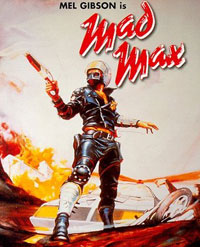
Despite the title, Max Rockatansky, only becomes ‘mad’ in the final third of this post-apocalyptic thriller. In fact, the character goes through a full character arc, from a cop trying to uphold justice and hold onto some stability in a world of chaos, to a man who thinks nothing of making a punk choose between sawing through his ankle or burning alive. A raw, energetic actioner with blistering car chases and an intense career-defining performance from Gibson.
71) Donnie Darko (2001)
It’s a mad world and it’s a mad film too, in Richard Kelly’s beguiling debut. Worm holes, a man in a rabbit suit, teen angst… What it all means is anyone’s guess, but the sparkling visuals and laconic performance from Jake Gyllenhaal make it stand out from the indie pack.
72) Soylent Green (1973)
Based on Harry Harrison’s influential novel Make Room! Make Room!, this dystopian thriller sees Chuck Heston’s cop uncovering the truth behind the titular foodstuff. Yes, yes, everyone knows the twist – whether they’ve seen it or not – but this efficiently directed film is a lot of fun, despite the bleak themes.
73) Cube (1997)
The original puzzle-based shocker – later examples include the Saw franchise, Fermat’s Room and The Collector. This playful, economical Canadian picture sees seven people attempting to escape from a cube of interlinked rooms laced with booby traps. The Crystal Maze was never like this. We wish it was though.
74) Moon (2009)
A welcome return to the slow-burning SF movies of the 1970s, Duncan Jones’s movie both draws on and subverts expectations of the genre. It’s a clever but accessible study of loneliness and liberty that boasts awesome modelwork and a haunting score by Clint Mansell.
75) Dark City (1998)

Another film that has steadily built up a cult following since its failure at the box office. Alex Proyas turns his perma-night city into an Expressionistic wonder, and the Kafkaesque plot is full of surprises.
76) Starship Troopers (1997)
Bug-busting thrills from Paul Verhoeven, in his third film in our list. This one’s a very loose take on Robert A Heinlein’s novel about marines fighting an alien menace, and it can be taken both as an anti-Fascist anti-militarism satire or an exciting, gung-ho alien war movie.
77) A Scanner Darkly (2006)
Reality bites in this appropriately wigged-out adaptation of the Philip K Dick novel. Richard Linklater applied the rotoscoping technique he’d used in Waking Life, and it proved to be the perfect marriage of style and content.
78) The Quiet Earth (1985)
This atmospheric New Zealand sci-fi drama, based on Craig Harrison’s novel, centres around two men and one woman who find that they’re seemingly the only ones left on the planet. A cult gem, this is one that deserves to be better known.
79) Invaders From Mars (1953)
They’re invaders. They’re from Mars. They’re invaders from Mars! A paranoid flying saucer chiller with cool (if not very convincing) tentacled Martians, an alien sandpit, an unsettling score and an endearing kiddie hero. Remade by Tobe Hooper in 1986.
80) Fantastic Voyage (1966)

A medical team are shrunk and injected into a dying diplomat’s body… The science is possibly suspect, but as concepts go it’s unbeatable. It was so good, in fact, that it was reused in the amiable 1987 comedy Innerspace.
81) Barbarella (1968)
Hard sci-fi this is not. But as kitsch retro fun it’s peerless, with Jane Fonda at her sexiest as the poster-friendly heroine and some wonderfully OTT set design. The iconic title sequence, in which Barbarella loses her clothes in zero gravity, has been much parodied, including in Kylie Minogue’s video for ‘Put Yourself in My Place’.
82) Fahrenheit 451 (1966)
Many critics at the time were unimpressed at Francois Truffaut’s step into English language mainstream moviemaking, but this stands up as an involving and faithful adaptation of Ray Bradbury’s novel about a book-burning future.
83) Twelve Monkeys (1995)
Terry Gilliam cuts back on his trademark Pythoneseque humour for a gripping reworking of La Jetée (see No. 29). A smart, off-kilter (and, unusually for Gilliam, commercially successful) genre picture that features an intense performance from Bruce Willis as mankind’s last hope.
84) Event Horizon (1997)
Event Horizon was mostly ignored on its original theatrical release but has since become a cult hit on DVD. Billed as ‘The Shining in space’, it’s got some silly dialogue but is packed with wonderfully scary moments.
85) Independence Day (1996)

Yes, yes, so it’s brash, jingoistic and about as subtle as a spade to the face. But the box office success of Independence Day led to the resurgence of the big sci-fi event movie, and it’s imbued with the spirit of a fun 50s B-movie on a modern Hollywood budget.
86) Altered States (1980)
Ken Russell’s offbeat approach to filmmaking always seemed suited to sci-fi, and they came together in this 1980 curio, based on Paddy Chayefsky’s novel. A scientist (William Hurt) experiments with psychotropic drugs and sensory deprivation, resulting in him changing into different evolutionary states. Trippy and truly bonkers.
87) The Stepford Wives (1975)
Ira Levin’s novels were the source for some movie classics (Rosemary’s Baby, The Boys From Brazil, er, Sliver), and one of the best was this satirical SF thriller about a town populated by submissive and strangely perfect women. It goes without saying that the 2004 remake should be avoided.
88) Serenity (2005)
Despite being much-loved by fans, Firefly was cut short after just 14 episodes (only 11 of which originally aired), so Joss Whedon had another go in the form of a movie. The extra budget (though small in comparison to other Hollywood pics) meant even better special effects, and Whedon’s ability to create endearing characters and witty, snappy dialogue is second to none.
89) Dune (1984)
It’s reviled by many fans of Frank Herbert’s novel, and even director David Lynch doesn’t like it very much. Yet, Dune is a grand, awe-inspiring and truly unique movie – exactly the kind of wonderful mess you’d expect if you asked a man like Lynch to create the next Star Wars.
90) Primer (2004)

See kids, maths can be fun! This micro-budget oddity centres on a couple of engineers who create a time machine quite by chance. The complex (and, to most, unfathomable) scientific chit-chat makes this the very antithesis of ‘soft sci-fi’, but it’s a smart attempt to treat the time travel sub-genre in a realistic manner.
91) Explorers (1985)
Joe Dante’s family-orientated adventure still hasn’t quite received the recognition it deserves. For the most part it’s the amusing and honest tale of three kids who build a rocket to outer space. The final half an hour, when they arrive on a spaceship and meet a couple of aliens, is a joy to watch.
92) THX 1138 (1971)
Before Star Wars, George Lucas created a very different kind of SF film with this dystopian story that’s heavily influenced by Nineteen Eighty-Four. The narrative may not be entirely original but the visuals are, and the film has an unsettling atmosphere and a memorable ending.
93) Star Trek (2009)
J.J. Abrams pulled off the not inconsiderable challenge of making Star Trek popular again – even cool – in a film that manages to appeal to Trekkers and newbies alike. Thrilling action sequences, charming performances, sex appeal and unobtrusive in-jokes.
94) Flash Gordon (1980)
Mike Hodges’ take on pulp space hero Flash Gordon is a stunning visual ride, packed with rich detail and surprises. Perfect casting (especially Brian Blessed as Prince Vultan), a bombastic Queen soundtrack, gaudy costumes and a campy sense of humour – what more could you want?
95) Galaxy Quest (1999)
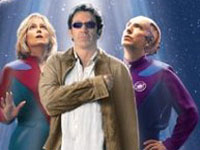
If Spaceballs was likeable but obvious, Galaxy Quest is a much smarter breed of SF spoof. The film gently sends up Star Trek while retaining an affection for the source material, and features a lovably dopey crew and the brilliantly optimistic aliens, the Thermians.
96) Cocoon (1985)
A life-affirming movie in more ways than one. Cocoon was a rare genre picture to feature interesting, non-stereotypical elderly characters (played by veterans Don Ameche, Wilford Brimley, Hume Croyn, Jessica Tandy), along with Tahnee Welch at her sexiest and Steve Guttenberg at his least annoying, and the film manages to be affectionate without descending too far into sentimentality.
97) Stargate (1994)
The movie that sparked off 10 years of SG-1, 5 seasons of Atlantis and the upcoming Stargate: Universe, Roland Emmerich’s movie scores due to a simple but clever concept and inventive effects. Like Emmerich’s later Independence Day, it’s corny at times, but it adds to the ‘B-movie with a budget’ charm.
98) Predator (1987)
A sci-fi spin on the slasher template, this sees an alien hunter stalk a bunch of commandos in the Central American jungle. But the extra-terrestrial menace doesn’t bank on dealing with the Austrian Oak… One of Arnie’s best 80s actioners, this is exciting stuff, tightly directed by John McTiernan. Plus you get some fine Arnie quips (“Knock knock!”) and the chance to have fun trying to spot Carl Weathers’ real arm tied behind his back as it’s blasted off.
99) Trancers (1985)
Producer/director Charles Band has been responsible for hundreds of low budget SF, horror and fantasy movies, and this popular Terminator-influenced thriller is probably his best work. Future cop Jack Deth (the amiably grizzly Tim Thomerson) is sent back in time to track down a baddie who can turn peeps into zombies. Five sequels so far.
100) Rollerball (1975)
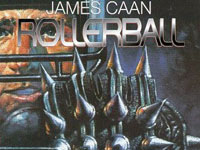
Who knew rollerskating could be so brutal? In the near future, the titular sport involves whacking a ball into your contestant’s goal by any means necessary. A classic anti-authoritarian anti-corporation narrative married to crunching Rollerball game sequences. The 2002 remake is virtually unwatchable.














 Source
Source













 The movies on this list are a good indicator of just how diverse the science fiction genre is. From the epic philosophical ideas of 2001: A Space Odyssey and Solaris to the joyful space opera of Star Wars and Flash Gordon, the films here are linked by their ability to explore time and space with imagination, flair and audacity.
The movies on this list are a good indicator of just how diverse the science fiction genre is. From the epic philosophical ideas of 2001: A Space Odyssey and Solaris to the joyful space opera of Star Wars and Flash Gordon, the films here are linked by their ability to explore time and space with imagination, flair and audacity. 





























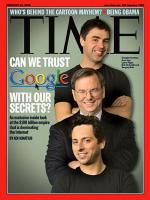





































 I like Firefox but it’s not as fast as it used to be. This is a comprehensive, safe guide to optimizing Firefox 3.5 for speedy browsing. For each suggestion, your mileage may vary. Before you proceed, create a new profile.
I like Firefox but it’s not as fast as it used to be. This is a comprehensive, safe guide to optimizing Firefox 3.5 for speedy browsing. For each suggestion, your mileage may vary. Before you proceed, create a new profile.





